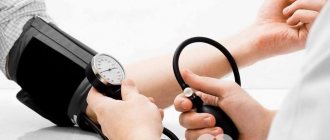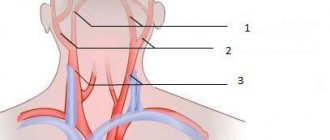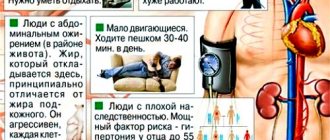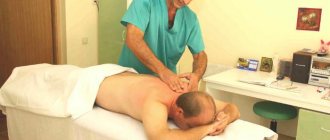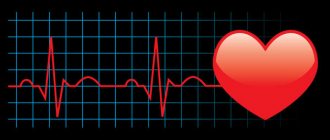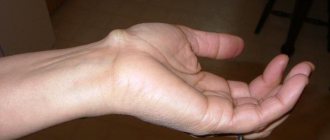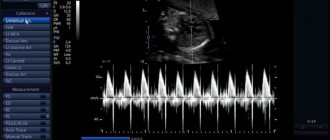How to measure blood pressure correctly, and on which arm
In order to have the most accurate, informative answer on the tonometer, it is customary to measure blood pressure more than once.
So, upper and lower pressure is always measured in a calm state, and if a deviation from normal values is detected, take a ticket to see a therapist. Quite often, a person randomly discovers that his blood pressure rises from time to time, and then returns to normal on his own. This may be an expression of the first degree of arterial hypertension.
At this stage, the pressure rises sporadically, the numbers on the tonometer are not yet very high. The person does not take any action to normalize blood pressure - it itself returns to its usual levels. But this does not mean that there should be no reaction: usually at this stage, lifestyle correction is necessary (proper nutrition, giving up bad habits, regular physical activity).
And if no measures are taken, the disease will certainly progress.
Blood pressure control is one of the measures to prevent the development of hypertension. A person can actually accidentally discover that he has high blood pressure. He feels well, there is no headache, no excessive sweating, no redness of the face, and the tonometer shows high values.
You need to measure your blood pressure twice a day, strictly at the same time. To make characteristic measurements, it is recommended to use an automatic device. Before the session, do not smoke for at least an hour, and you should not drink on this day if you want to see true readings on the device screen.
Blood pressure measurement algorithm:
- The cuff is placed in the heart area, and the acceptable level is considered to be 20 mm above the elbow;
- The pear needs to be diligently pumped into air;
- In order for a person to maintain a comfortable state, it is ideal for someone else to measure blood pressure;
- The air is pumped until the pulse disappears when listening. This is considered a marker of diastolic (bottom) pressure;
- After the manipulations are completed, air is released until the pulse begins to be heard again. This is considered the systolic (upper) pressure mark.
The values will not be correct if the hand is located above or below the heart zone. If the patient has nothing to rest his back on while measuring blood pressure, then the readings are likely to be overestimated. A very tightly tightened cuff can also affect the numbers on the blood pressure monitor.
If, for example, you have a runny nose and you use nasal drops, they can affect your blood pressure. Eye drops can also interfere with the reliability of pressure measurements.
If everything is done correctly, and it is periodically discovered that the pressure on the hands is really different, you need to find out what provokes this state of affairs. Perhaps the cause is a violation of the patency of the arteries of the arms. This pathology can be provoked by atherosclerosis, thrombosis, aneurysm, scalene muscle syndrome, tumor formations of soft tissues in the shoulder or sternum, trauma or other vascular deformations.
Possible diseases
Different pressures on the left and right hands are detected in various pathologies that are associated with damage to blood vessels and other structures of the body. In clinical practice, most often the cause is arterial atherosclerosis, vegetative-vascular dystonia, heart disease, Takayasu's disease, pregnancy and a number of other conditions.
Atherosclerotic lesion
Atherosclerosis occurs in 60-70% of elderly people. The disease is characterized by the formation of fibrous plaques in the artery wall, which narrow the lumen of the vessel and disrupt blood flow. If the subclavian or brachial artery is damaged, a change in its lumen can lead to a decrease in pulse pressure, which explains why different arms have different levels of blood pressure when measured.
With atherosclerosis, the difference between the left and right hands can reach 20-30 mmHg. The patient may not have any other complaints, and pressure asymmetry is discovered by chance during preventive medical examinations or when visiting a medical facility for another reason.
Vegetative-vascular dystonia
Disturbances in the balance of the sympathetic and parasympathetic nervous systems lead to the development of vegetative-vascular dystonia (VSD). The disease is characterized by disruption of the functioning of internal organs (heart, intestines, etc.) and blood vessels. The main reason for the difference in the hands when measuring blood pressure is a disorder in the regulation of the lumen of blood vessels. Arteries with VSD can be dilated or narrowed, which causes changes in blood pressure levels.
Heart diseases
Pathology of the heart muscle in the form of ischemia or rhythm disturbances occurs in every 3rd person. In the absence of timely diagnosis and treatment, heart disease can lead to asymmetry of pressure in the hands. This is observed in coronary heart disease, congenital and acquired malformations, arrhythmias of various origins. In addition, the difference in blood pressure may be due to coarctation or dissection of the ascending aorta or arch.
Takayasu's disease
The disease is characterized by the development of inflammatory changes in the areas of branching of the arteries. As a result of inflammation, the initial part of the vessels narrows, forming a mechanical obstacle to blood flow, reducing the level of blood pressure in it. The development of Takayasu's disease is typical for young women, since the disease is in the nature of an autoimmune lesion.
Diabetes
Elevated glucose levels are a risk factor for the development of atherosclerotic lesions of arteries of various locations. Plaques that form in the wall of blood vessels reduce the level of blood pressure in one arm, due to the mechanical closure of the vessel. In addition to atherosclerosis, diabetes mellitus leads to myocardial ischemia and heart rhythm disturbances, which can also cause pressure asymmetry.
Osteochondrosis
Degenerative-dystrophic changes in the intervertebral discs lead to osteochondrosis. In addition to neurological manifestations and pain, the disease can be characterized by asymmetry in blood pressure when measured in both arms.
The role of the musculoskeletal system
The condition of the musculoskeletal system greatly affects the condition of the blood vessels. For example, fibrotic changes in muscles resulting from muscle injuries lead to mechanical compression of the vascular bundle. Such changes change the level of blood pressure in both arms, leading to its asymmetry.
Healthy:
Who needs treatment
If the pressure difference between the left and right hand does not exceed 10 mmHg. st – no treatment is required at all. If this difference increases by more than 15–20 points, you need to contact a specialist. This could be a family doctor or internist. You may need specialized treatment under the supervision of a vascular surgeon, neurologist, or cardiologist.
This may require:
- Regular tonometry (measurement of indicators).
- Taking medications that restore vascular patency, slow the progression of atherosclerosis or aortoarteritis, thin the blood and improve blood circulation.
- Drug treatment of hypertension and vegetative-vascular dystonia.
- Gymnastics and physiotherapy for the upper limb girdle and physiotherapeutic procedures for this area.
- Surgical treatment - removal of blood clots, cholesterol plaques, placement of stents and even replacement of damaged arteries with an artificial prosthesis.
Treatment for pressure differences between the right and left hands
If you seek help immediately after detecting such a deviation, treatment will help eliminate not only the pressure deviation, but also its cause. Targeted treatment completely solves the problem - you can be cured.
When to see a doctor and what symptoms should alert you
Among the symptoms that occur with asymmetry of blood pressure levels in both arms are:
- Weakness in the arm. The patient cannot squeeze the hand, and strength is suddenly lost. This is usually observed on the side of the suspected lesion.
- Reduced blood circulation in the arm. The limb becomes bluish and cold.
- Paresthesia. Numbness of fingertips, loss of sensitivity. Nonspecific sign of circulatory disorders. It is also possible with osteochondrosis of the cervical spine. Plus symptoms characteristic of hypertension or hypotension.
There are also manifestations that require urgent medical attention; it is better to call an ambulance:
- Acute headache for no apparent reason. Patients describe it as blows with a blunt object to the crown or back of the head.
- Distortion of the face or half of the body. A threatening sign. Talks about a possible stroke. Concomitant symptoms increase gradually or fall upon the patient like an avalanche, depending on the type of circulatory disorder in the cerebral structures. Hemorrhagic stroke is much more severe.
- Constant dizziness. In an acute state, it borders on complete disorientation in space.
- Incomprehensible speech, impaired speaking process.
- Paralysis, paresis of half the body or the whole body.
- Chest pain. Usually during a heart attack they are not strong, but annoying, they radiate to the epigaistria (the area above the abdomen) and do not allow normal breathing. Read more about the signs of a pre-infarction condition.
Symptoms are taken into account as a whole. Depending on the nature of the manifestations, you need to either hospitalize the patient in a cardiology or neurological hospital, or quickly get help on the spot and consult a doctor as soon as possible.
Clinical manifestations of pathology
The main reason for low blood pressure in one arm is impaired blood circulation due to blockage of blood vessels.
In this case, the pathology is accompanied by the following symptoms:
- the strength of the hand is weakened;
- the fingers turn pale and cold, there is numbness;
- the skin on the fingertips, and often on the entire hand, may acquire a bluish tint.
When the pressure on the right hand decreases, in addition to the above signs, symptoms appear indicating a circulatory disorder in the brain:
- headache and dizziness;
- nausea and vomiting;
- speech difficulties;
- weakening of memory and absent-mindedness;
- facial distortion;
- paralysis of one side of the body.
This situation is due to the fact that the arteries supplying the right arm and brain with nutrients and oxygen depart from the aorta in one trunk.
What influences the difference in indicators
There are several important points that can affect blood pressure levels in different arms. Among them:
- Technique used. Automatic blood pressure monitors are considered more convenient because they do not require any skills on the part of the patient or, more precisely, the user. However, accuracy suffers.
Mechanical devices are more accurate, but their use requires some skill.
Thus, a banal hardware error is possible. The error in cheap automatic devices is within 5-10 mmHg.
- Time of the study. The most accurate results are in the morning. As we move towards evening, a person is influenced by many factors of various kinds. These include stress, nutritional factors and physical overload.
Therefore, for the accuracy of the result, it is recommended to measure three times a day: in the morning before the first meal, before 14.00 before lunch and in the evening, right before bed, when the body is preparing to rest.
If the numbers differ significantly within a significant range all three times, you can assume that something is wrong.
- Compliance with measurement rules. Doctors are familiar with them, but not all of them. Depends on the competence of a particular specialist.
When measuring blood pressure, you need to sit up straight, do not tighten the cuff too tightly, do not lean back in your chair, do not strain, and place your hand at the level of your heart in order to cause a false increase in blood pressure.
Only if all recommendations are followed, the result will be accurate. Otherwise, you need to wait 10-15 minutes and repeat the procedure.
- Different hands have different pressures - this is an axiom, and you should not be afraid of such a phenomenon. Typically, the blood pressure level is higher on the leading limb. A deviation of 11 mmHg or more is considered pathological.
- Fatigue, overwork. As a rule, with significant negative effects on the body, the blood pressure level will be different in different arms. A tired patient is not a good example. You need to measure your blood pressure while you are awake.
When not to panic
As already mentioned, almost half of people have deviations in their indicators. It is considered normal if it does not exceed 5-10 units. In addition, if blood pressure is slightly elevated, then the likelihood of a physiological abnormality is much higher than if low blood pressure is noted in one arm.
In all cases, the difference is considered individually, taking into account the characteristics of the patient.
The pressure may be increased on the left arm. This deviation is observed in almost all right-handers. In this case, the difference will be barely noticeable, that is, within 5-8 units. But in left-handed people, the blood pressure on the right hand may be 15-18 units lower. This is explained by the fact that the artery located on the right arm arises directly from the aorta. Accordingly, the blood pressure in it will be significantly higher than in other vessels. The vessel on the right arm already departs from the brachiocephalic trunk. Therefore, the pressure in it is slightly lower.
Hand pressure readings are often very individual, and a slight deviation may be normal.
It may also turn out that blood pressure is higher on the right arm. Normally, this is observed in right-handed people who are often engaged in physical work. The reason for this deviation is that as a result of regular exercise, muscle mass increases. It compresses the blood vessels, which leads to increased pressure in the muscle area. Therefore, if you carry heavy objects with your right hand throughout the day, the pressure on it will be significantly higher in the evening.
How to correctly understand whether this is normal or pathological
Before looking for reasons in your own health, it is recommended to make sure that the difference in pressure on the right and left hand is not the result of a malfunction of the tonometer. And is it worth believing the readings of an individual device? If the problem is not in the device, then different pressure on the hands, the cause and treatment will be mandatory and urgent issues that need timely resolution.
According to numerous medical studies, it has been found that the difference in blood pressure in the right and left arms, exceeding more than ten millimeters of mercury, may indicate the presence of diseases of the vascular system of the extremities. If there is a stable difference in blood pressure readings in the arms above fifteen units, then there is a possibility of extensive damage to the vascular system of the brain, and this, in turn, is a direct factor in the development of stroke.
Different blood pressure in the arms provokes discomfort, expressed in weakness, tinnitus, lethargy, fatigue, and chilly limbs. However, in most cases, this pathology is detected solely by measurement. At the same time, differences in pressure in different hands also occur in people who do not suffer from high blood pressure. It is also worth noting that even in medical institutions this comparison is quite rarely carried out; basically, readings are taken, on the one hand.
A blood pressure difference not exceeding five units is considered normal and mainly occurs under the following factors:
- the occurrence of a stressful situation;
- individual anatomical and physiological structure of a person. According to statistical studies, more than fifty percent of people have high blood pressure on the right side and low blood pressure on the left side;
- the presence of vascular atherosclerosis;
- the presence of vegetative-vascular dystonia;
- chronic fatigue and lack of sleep.
Thus, if the pressure on the two arms has a large difference exceeding fifteen units, then atherosclerotic changes are most likely occurring in the body.
Factors influencing performance
Different pressure on the hands can be a result of various factors:
- Emotional instability. Indicators may increase due to stress, anger or joy. Sometimes the blood pressure on the right and left arms may differ from this. And when the person calms down and the adrenaline release stops, the pressure returns to normal.
- Features of the anatomical structure. In some people, the vessels on one arm may be close to the skin, and on the other, deeper. In this case, there will be a difference in indicators, but not very large. Arm musculature may also be affected.
- Improper blood circulation in one of the arms. This may be due to atherosclerotic plaques formed in its vessels. They block the lumen, as a result of which less blood will flow to the tissues.
- Heredity. The disease that causes this condition can be inherited.
- Chronic fatigue. If you measure blood pressure when a person is overtired, there is a high probability that there will be a difference in the readings.
- Cardiovascular pathologies. Different pressures on the right and left arms can be observed due to acute cerebral circulatory failure.
Is there different pressure on the right and left arm? Should you panic?
The correct technique for measuring blood pressure involves conducting a study on both arms (if there is no significant difference), and on the “non-working” one 2 more times to confirm the indicators.
Normally, in a healthy adult, the difference in values is allowed within 10 mmHg for systolic (upper) and 5 mmHg for diastolic (lower). Differences in these indicators indicate a disturbance in the passage of blood or a change in the tone of the vascular wall.
Most often, a difference of 10-15 mmHg is a clinically insignificant deviation that can occur in:
- patients with vegetative-vascular dystonia (VSD). An exacerbation of the condition is accompanied by a change in indicators due to spasm or relaxation of the muscles of the arterial wall;
- adolescents and elderly people with unstable tone regulation;
- athletes - due to developed muscle mass, which compresses the artery;
- people who work predominantly with one hand (most often higher performance on this hand);
- pregnant women. A woman’s psycho-emotional lability due to hormonal imbalance often causes periodic changes in blood pressure;
- people taking medications that affect vascular tone (including No-Shpa).
In a single case of diagnosing different pressures in the hands, you should not panic, since temporary fluctuations in indicators can also occur in a healthy person. You should consult a doctor if the difference persists after 3-fold measurements for several days.
Cause
Blood pressure is the resistance of the vascular wall, which is exerted to maintain normal lumen during the passage of blood. The value is determined by:
- blood volume (the less fluid in the stream, the lower the indicators);
- heart rate (low blood pressure is often accompanied by tachycardia - an increase in the number of contractions per minute);
- diameter of the lumen of the arteries;
- tone of smooth muscles in the thickness of the wall.
Violation of any of the indicators affects changes in blood pressure.
In addition, the tonometer used (electronic, mechanical or semi-automatic) and the measurement technique play an important role. When the cuff is placed on the forearm, lower values are recorded.
The main reasons for the difference in indicators and additional manifestations are presented in the table below.
| The reason for the different pressure on the hands | Mechanism and additional features |
| Stenosis (unilateral) of the brachial artery |
|
| Atherosclerosis of the artery |
|
| Diabetes |
|
| Compression of a vessel from the outside by a tumor |
|
| Aneurysm |
|
| Scalenus syndrome |
|
Another important reason for the difference in values is a previous injury or surgery in the shoulder area. .
Features of differences in blood pressure during pregnancy
Often the above condition is observed during pregnancy. There are several reasons why different arms have different blood pressure during pregnancy. And most often they indicate the following pathologies:
- Nonspecific aortoarteritis. This is a rather dangerous pathology associated with impaired immunity. An inflammatory process begins in the walls of blood vessels. Over time, this can lead to blockage of the lumen. As a result, blood may not flow to all internal organs. This can lead to oxygen starvation of the body. Due to blockage of the lumen, the blood circulation process is disrupted, so the blood pressure level may change. This disease often ends in death. Therefore, it is very important to diagnose it in time and begin treatment.
- Hormonal problems. Due to excess corticosteroids in the female body, blood pressure regulation may be disrupted. As a result, one arm may have normal blood pressure, while the other may have low or high blood pressure. The difference between the indicators will be small - about 10-15 mm Hg.
- Complications at any stage are eclampsia and preeclampsia. Such conditions are very dangerous and can lead to large differences between blood pressure readings.
- Late toxicosis. Accompanied by very pronounced symptoms of intoxication, the general condition of the woman is disturbed. It also leads to large pressure differences in the arms – up to 30 mm Hg.
Different pressure in the hands during pregnancy may indicate hormonal problems.
Therefore, during pregnancy, it is necessary to regularly see a gynecologist. Otherwise, the above pathologies can lead to serious complications, including miscarriage and even death of the woman.
Contraindications before the procedure
Before measuring your blood pressure, you need to find out what not to do an hour before the procedure:
- get physical activity;
- worry;
- smoke;
- There is;
- drink alcoholic beverages, as well as strong tea and coffee.
Blood pressure is measured several hours after taking antihypertensive drugs so as not to distort the results. For this reason, treatment of hypertension must be properly combined with constant blood pressure monitoring. This also includes any nasal or eye drops that could affect your readings.
If your condition worsens due to arterial hypertension, it is extremely important to know how to measure blood pressure at home, because you will have to do this almost every hour. All results must subsequently be shown to the doctor so that he can see the dynamics of the disease.
Algorithm for measuring pressure on both hands
In order for the results to be accurate, a number of simple rules must be taken into account when measuring blood pressure:
- If measurements are taken regularly, it is recommended to do this twice a day at the same time. It is best to measure blood pressure in the morning from 7:00 to 9:00, and in the evening from 19:00 to 20:00. It is advisable to record all data in order to compare daily results. If a person suffers from arrhythmia, it is recommended that he take 3 measurements at a time, with a difference of 3 minutes between them. If this interval is not observed, repeated results may be inaccurate because the arm will not have time to resume normal blood flow after compression by the cuff.
- For an hour before measuring blood pressure, smoking, drinking alcohol, and any physical activity are prohibited.
- Measurements should be taken in a sitting position, with your elbows resting on a hard surface. Before doing this, it is recommended to rest for 5 minutes. There is no need to talk or move during the measurement process. If a person cannot sit in a sitting position for health reasons, measurements can be taken while lying down. But this is only allowed in special cases.
- The tonometer cuff must be placed so that it is at the level of the heart. This is approximately 2 cm above the bend of the elbow. It is advisable to apply it to the skin, or over a sleeve made of thin fabric, if it does not squeeze the hand.
- The question often arises: if there are different pressures on the hands, then which one is correct. The one above is considered correct. Therefore, if blood pressure is measured for the first time, you should first check it on both arms. In the future, carry out the procedure on the limb where there was higher pressure.
How to measure the pulse on your hand yourself: its norms
The main function is to reflect vibrations of the walls of blood vessels, which depend on heart contractions.
Pulse indicators carry information about the condition of the blood vessels, since it characterizes the strength and rhythmicity of the movements of the walls of blood vessels. Irrhythmic heart contractions can be a signal of various heart diseases that require treatment. If there is no pulse in the hand, it can be listened to on the carotid artery.
When the next portion of blood is pushed out, it hits the walls of the blood vessels, causing them to vibrate. On the human body, the vibration of blood vessels can be easily felt by palpation.
Most often, the pulse is measured on the arm. It is for this reason that experts give advice on how to measure the pulse on your hand yourself.
This skill will allow you to monitor your condition at any time, as well as determine your blood pressure using your pulse.
Algorithm for performing the manipulation
You can measure your pulse yourself in your wrist as follows:
- The frequency of the blows is measured with the fingers around the wrist.
- The characteristics of pulsations are determined in 1 minute (in 30, 15 or 10 seconds).
- It is more correct to look for the pulse simultaneously in the right and left radial arteries, comparing their characteristics, which normally should be the same.
- The received data is recorded in the form of a graph or picture throughout the day.
- If the pulse cannot be felt in your hand, you can count the frequency and strength of the heartbeat in another place.
When it is impossible to detect the heartbeat even in the carotid artery, cardiac arrest is possible. In this case, it may be necessary to carry out special manipulations that stimulate the heart to restore its function.
Rules for measuring the indicator
You need to know how to measure your pulse on your arm or elsewhere:
- This must be done at rest, so that the readings are accurate, in a sitting or lying position.
- You should not measure the frequency of impacts with your thumb. This will lead to measurement errors. Take measurements correctly with your index finger or two at once.
- Veins and capillaries do not transmit heartbeats; it is impossible to determine the number of beats from them. For this reason, it should be measured by arterial contractions.
- You need to install the stopwatch so that it is easy to monitor.
- It is better to count the number of beats within 1 minute. But you can also multiply the result by 4 (or 2) in 15 (or 30) seconds. This is faster, although it increases the chance of error when the rhythm is irregular. The most accurate measurement is 1 minute.
Today, not manual methods of measuring heart rate are more common, but using hand sensors or heart rate monitors - cardiometers. They are worn like a watch or strengthened in the elbow. The device screen constantly displays information about heart rate or at certain intervals.
This method is preferable to palpation, since the measurements are more accurate and no skills are required. With this device you can monitor your heart rate at home and during physical activity without stopping to take measurements.
But these devices are not certified, so they are not suitable for diagnostics.
The heart rate is also determined when taking a cardiogram.
It is possible to measure pulsation using automatic pressure measuring devices (tonometers). Simultaneously with pressure readings, such devices display heart rate on the screen. If the pulse is unstable, such a device indicates this. Some doctors use a stethoscope for this purpose to hear the heartbeat.
Measuring points
Pulsation is determined where the artery passes close to the surface of the body over the bone tissue. Most often, the pulse is measured on the arm. But this is not the only place of measurement.
Measure pulse:
- on the wrist,
- in the bend of the elbow,
- in the temple area,
- on the neck,
- in the groin,
- under the knee,
- on the legs, or rather, on the ankles on the inside,
- in the pubic region (inguinal arteries),
- in the area of the carotid artery,
- at the junction of the big toe and foot from below.
How to measure pulse on your hand
The easiest place to find the pulse is in the wrist area. To count the pulse on your hand, no special skills or equipment are required. Anyone can measure their heart rate.
The procedure for measuring heart contractions is very simple:
- it is necessary to remove everything from the hand that could interfere with the movement of blood through the vascular system,
- wash your hands and dry them,
- lie down or sit down
- prepare a watch with a second hand or a stopwatch,
- press the radial artery with three fingers,
- count the number of beats:
- It’s better to do this in a minute, but you can count the beats for 30 seconds, then multiply the result by 2 (If the pulse is calculated in 15 seconds, the result is multiplied by four),
- record the results.
This method of measuring heart rate does not require special skills.
How to determine the pulse on the carotid artery
To perform the procedure for measuring heartbeats in a place close to the carotid artery, two or three fingers are used. They are located on the side of the lower jaw or the sternocleidomastoid muscle near the thyroid cartilage. In this way, the number and force of blows on a person are counted, and some conclusions are made about the character.
Attention! The measurement must be taken carefully to avoid squeezing the artery, which could cause the risk of a sudden slowdown in heart rate. This can lead to loss of consciousness.
What heart rate is considered normal?
There are fixed indicators that determine the normal number of heartbeats. The numbers are different for each age.
This indicator is:
- in newborns about 140 beats/min,
- in babies under one year old it is about 130 beats/min,
- from one to two years – 90–100 beats. /min,
- in children 2–7 years old – 85–95 beats. /min,
- 7–14 years – this figure is lower – 70–90 beats/min,
- up to 30 years – 60–70 beats per minute,
- in an adult 30–50 years old, the pulse is 60–85 beats/min,
- in people over 50, about 95 beats. /min,
- Athletes who train a lot have a heart rate of 40–60 beats per minute.
Attention! Deviation of heart rate from the norm is an alarming sign! But if such a deviation in the indicator is observed for a long time, and the person feels well, such a person’s pulse is considered normal. But in any case, you need to see a doctor!
What do the increased indicators indicate?
Increased heart rate can be caused by physiological and pathological reasons. They become more frequent, for example, after overexertion and strong emotions, after intense sports training. But after some time, the frequency of contractions returns to normal.
If the pulse quickens at rest, this is pathological. When the heart rate is more than one hundred per minute, doctors make a diagnosis: tachycardia. It is evidence that the heart cannot pump blood as it should. This condition occurs when:
- heart failure,
- cardioneuroses,
- IHD,
- heart defects,
- endocarditis or rheumatic carditis,
- thyrotoxicosis,
- anemia,
- hypertension and simple arrhythmia.
Only a doctor can check and confirm the diagnosis.
Slow heart rate
This phenomenon is caused by the myocardium associated with the replacement of muscle tissue with scar tissue if the sinus node is affected.
Often the reasons for a low heart rate are irregular heartbeat and disorders of internal organs. Doctors call this condition bradycardia. This happens:
- with extrasystoles,
- in cases of atrial fibrillation,
- with heart block.
Low pulsations can be caused by:
- prolonged hypothermia,
- increased pathologies of the parasympathetic nervous system,
- an increase in intracranial pressure, which is caused by cerebral edema, tumors, cerebral hemorrhages and meningitis,
- using certain medications, such as beta blockers or antiarrhythmics,
- intoxication,
- dysfunction of the thyroid or pancreas,
- various infections.
In addition, a decrease in the number of contractions often occurs in athletes and healthy people undergoing physical activity. Bradycardia in these people is normal if it does not manifest itself in any abnormalities.
Diagnostics by pulse
During the ruling Chinese dynasty, pulse diagnosis was widely used to determine the condition of a monarch. The doctors could touch them only to measure his pulse. An incorrect diagnosis cost the healer his life. And they counted the frequency, uniformity and strength of the monarch’s heart contractions. They were diagnosed.
For diagnosis by heart contractions, the frequency of beats, their strength, and fullness are still taken into account. For example, place three fingers of the right hand in the place of the left wrist, where the radial artery is located, so that the heart contractions are felt by each finger. They remember under which finger the blows are felt more strongly. The same is done with the left hand.
If, when pressed in the left wrist, the heart beats under the pad of the index finger, this is a signal of a disease of the small intestine in a man, and a disease of the large intestine in a woman. The depth of the beats under the same finger indicates the condition of the heart in men or lungs in women.
Deep palpitations in the wrist of the right hand indicate pathologies of the lungs in men and heart pathologies in women. Similarly, superficial heartbeats indicate pathologies in the intestines, but, on the contrary, from pathologies of the left hand.
It is impossible to accurately measure blood pressure using heart rate readings alone, but you can find out whether your blood pressure is high or low. It disappears for a few seconds, and then the pulse appears again due to arrhythmia. With osteochondrosis, the frequency of impacts on different hands is different.
Source: https://vrednuga.ru/gipertenziya/metody-izmereniya-pulsa-na-ruke-v-domashnih-usloviyah
Treatment
If, during the measurement of systolic and diastolic pressure parameters on the right and left arm, the tonometer showed different values, the person should:
- calm down. Deep and even breathing helps relieve anxiety;
- engage in restoration of the nervous system;
- improve nutrition, start leading an active lifestyle;
- do not measure blood pressure if you are very tired or after physical and mental stress;
- if there is a suspicion of atherosclerosis, then you need to sign up for a Doppler ultrasound to check the condition of the blood vessels;
- In case of severe deviations in blood pressure values, it is recommended to undergo a full examination in the hospital.
To eliminate pressure asymmetry, which is a symptom of the disease, treatment is carried out. Drug therapy should be aimed at combating the main pathology.
To get rid of cardiovascular diseases, the following drugs can be used:
- Magnesium B6 . Contains magnesium, pyridoxine and stabilizing elements. Strengthens the immune system, improves the condition of the heart muscle, and increases stress resistance. A sufficient amount of magnesium and vitamin B6 in the body is necessary to reduce the likelihood of stroke, heart attack, and atherosclerosis;
- Nitroglycerin . Relieves spasm of smooth muscle fibers due to the expansion of coronary arterioles. Increases the flow of oxygenated plasma to the heart, reduces congestion, and reduces the load on the heart muscle.
In some cases, surgery is indicated. We are talking about tumors and heart defects.
You can reduce the difference in pressure between the two limbs using alternative medicine. Traditional healers advise eating dried apricots. Dried apricot restores the functioning of internal organs, stabilizes hormone levels, and improves the functioning of the cardiovascular system.
If there are slight differences in blood pressure on the right and left arms, it is recommended to take a decoction of thyme. It relieves nervous tension, depression, spasm of cerebral vessels, and normalizes sleep. The plant dilates arteries and equalizes pressure. You can drink a decoction of thyme instead.
Hawthorn infusion gently reduces blood pressure
Hawthorn is considered a good remedy in the treatment of cardiovascular disorders. Thanks to the unique composition, the fruits of this plant eliminate arterial spasm, reduce blood pressure, and restore heart rhythm.
One tablespoon of hawthorn berries is poured into a glass of boiling water and left for a couple of hours . Then filter and take two tablespoons several times a day before meals.
Sometimes you can eliminate the difference in blood pressure in both arms by revising your diet and regimen
It is important to eat only healthy foods. There is no special diet that reduces the difference between the tonometer numbers on the right and left hands
It is selected based on the disease that caused such a defect.
When difference is dangerous
First of all, you should think about pathology if the difference in two indicators on both hands is more than 20 units. Accordingly, the higher the difference, the more serious deviations in the body are observed. The following deviation options are possible:
- If the pressure on one side is significantly higher than on the other, diseases such as VSD, pathologies in the structure of the aorta, and disorders in the function of the subclavian vessels should be excluded.
The difference in pressure on the left and right can occur with VSD
- If the pressure is increased on both hands, but there is a difference between the numbers of more than 20 units. A similar deviation can be observed with advanced hypertension, disorders of neurocirculatory function, and the cause may also be severe stress, lack of sleep, and so on.
- If the pressure on one arm is greatly reduced, while on the other it is significantly increased. A condition that requires special attention. The main cause may be a violation of the patency of the brachial or subclavian artery.
The following diseases can also provoke a decrease in blood pressure on the one hand and an increase in pressure on the other:
- Atherosclerosis - pathology occurs with the formation of plaques, due to which the lumen of blood vessels changes, and the changes are observed unevenly.
With thrombosis, a pressure difference may also occur
- Thrombosis is a violation of vascular patency as a result of a blood clot.
- An aneurysm is a pathological change in the structure of the vascular wall, in which the formation of a sac-like expansion is noted, which affects pressure indicators.
- Aortoarteritis is an inflammatory process involving the walls of blood vessels.
- Scalenus syndrome occurs with changes in the structure of the muscle fibers through which the vessels pass.
- Tumors - any formations located in the chest or neck area can disrupt the functioning of blood vessels.
- Injuries and surgeries - any interventions negatively affect the condition of tissues due to the high risk of the formation of adhesions that impair the patency of blood vessels.
Please note that after injuries and surgeries, pressure differences can also be a side effect
You need to pay special attention to your health if there are accompanying symptoms. If the patency of blood vessels is impaired, there may be complaints that there is a decrease in strength in the arm on the affected side. When palpated, the fingers are much colder than the skin in the wrist area. In some cases, you may notice bluishness of the tips.
With a decrease in blood pressure in the right arm, symptoms of circulatory disorders in the brain appear.
This pattern is explained by anatomical features, namely by the fact that the arm and brain are fed by vessels extending from the common aorta. This can be determined by the following signs:
- headache;
- speech disorders;
With low pressure on the right side, severe headaches may be an accompanying symptom.
- facial asymmetry;
- memory impairment;
- paralysis of the limbs (noted only on one side).
Thus, we can conclude that when measuring pressure on two arms, when obtaining different indicators, it is necessary to take into account the largest one, and based on these numbers, select treatment.
